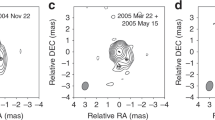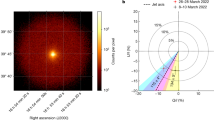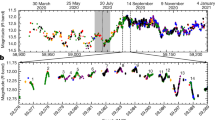Abstract
Blazars (BL Lac objects and optically violently variable quasars) are characterized by high optical polarization, and highly variable optical flux, polarization and polarization position angle1. Many have other extraordinary properties that could be explained by a radiating jet undergoing bulk relativistic motion directed towards the observer. Several workers have suggested that the jets seen in ordinary double radio sources could appear as blazars, if they were viewed end-on1; in this case the two lobes would not appear separately, but would appear in projection as a halo around the point source. Generally, blazar maps in the literature are consistent with this notion2–4, with only two unusual (bent or very asymmetrical) double sources—1400 + 162 (refs 3–6) and 3C279 (ref. 7)—having been reported. However, we have now found three clear double radio sources (two being quite symmetrical) around the strong central point sources, including one classical double. A fourth blazar has head–tail morphology. It may be possible to reconcile these observations with the model cited above if we imagine that the jets do not lie precisely alone the line of sight, or that the lobes are misaligned with the jets8.
This is a preview of subscription content, access via your institution
Access options
Subscribe to this journal
Receive 51 print issues and online access
$199.00 per year
only $3.90 per issue
Buy this article
- Purchase on Springer Link
- Instant access to full article PDF
Prices may be subject to local taxes which are calculated during checkout
Similar content being viewed by others
References
Angel, J. R. P. & Stockman, H. S. A. Rev. Astr. Astrophys. 18, 321–362 (1980).
Ulvestad, J. S., Johnston, K. J. & Weiler, K. W. Astrophys. J. 266, 18–27 (1983).
Wardle, J. F. C., Moore, R. L. & Angel, J. R. P. Astrophys. J. (in the press).
Stannard, D. & McIlwrath, B. K. Nature 298, 140–144 (1982).
Baldwin, J. A. et al. Astrophys. J. 215, 408–416. (1977).
Hintzen, P. & Owen, F. Astr. J. 86, 1577–1584 (1981).
Browne, I. W. A. et al. Nature 299, 788–793 (1982).
Schilizzi, R. T. & de Bruyn, A. G. Nature 303, 26–31 (1983).
Cohen, M. H. & Unwin, S. C. IAU Symp. 97, 345–354 (1982).
Condon, J. J. & Dennison, B. Astrophys. J. 224, 835–840 (1978).
Condon, J. J., Ledden, J. E., O'Dell, S. L. & Dennison, B. Astr. J. 84, 1–11 (1979).
Moore, R. L. in Proc. of Workshop on Low Frequency Variability of Extragalactic Source 21–22 April, Green Bank, West Virginia, 49–53 (National Radio Astronomy Observa tory, Charlottesville, 1982).
Perley, R. A., Fomalont, E. B. & Johnston, K. J. Astrophys. J. Lett. 255, L93–L97 (1982).
Baldwin, J. A. Astrophys. J. 201, 26–44 (1975).
Fanaroff, B. L. & Riley, J. M. Mon. Not. R. astr. Soc. 167, 31–35 (1974).
Miley, G. K. A. Rev. Astr. Astrophys. 18, 165–218 (1980).
Moore, R. L. & Stockman, H. S. Astrophys. J. 243, 60–75 (1981).
Pica, A. J. et al. Astr. J. 85, 1442–1461 (1980).
Spangler, S. R. & Cotton, W. D. Astr. J. 86, 730–746 (1981).
Smith, H. E. et al. Astrophys. J. 215, 427–437 (1977).
Peterson, B. A., Jauncey, D. L., Wright, A. E. & Condon, J. J. Astrophys. J. Lett. 207, L5–L8 (1976).
Fosbury, R. A. E. & Disney, M. J. Astrophys. J. Lett. 207, L75–L77 (1976).
Gilmore, G. Mon. Not. R. astr. Soc. 190, 649–667 (1980).
Porcas, R. W. Nature 294, 47–49 (1981).
Author information
Authors and Affiliations
Rights and permissions
About this article
Cite this article
Antonucci, R., Ulvestad, J. Blazars can have double radio sources. Nature 308, 617–619 (1984). https://doi.org/10.1038/308617a0
Received:
Accepted:
Issue Date:
DOI: https://doi.org/10.1038/308617a0
This article is cited by
-
Radio observations of the BL Lae object 1400+ 162
Journal of Astrophysics and Astronomy (1984)
Comments
By submitting a comment you agree to abide by our Terms and Community Guidelines. If you find something abusive or that does not comply with our terms or guidelines please flag it as inappropriate.



